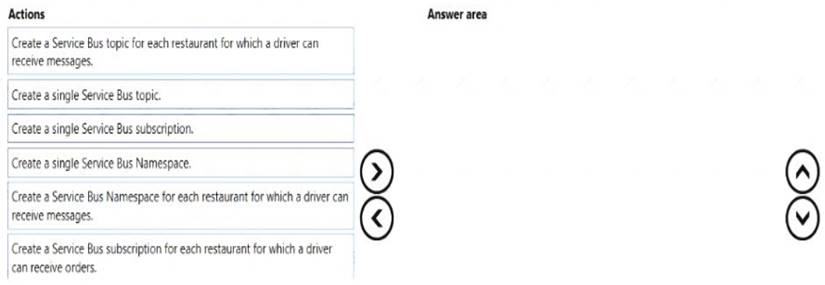- (Exam Topic 8)
You develop and deploy an Azure Logic App that calls an Azure Function app. The Azure Function App includes an OpenAPI (Swagger) definition and uses an Azure Blob storage account. All resources are secured by using Azure Active Directory (Azure AD).
The Logic App must use Azure Monitor logs to record and store information about runtime data and events. The logs must be stored in the Azure Blob storage account.
You need to set up Azure Monitor logs and collect diagnostics data for the Azure Logic App.
Which three actions should you perform in sequence? To answer, move the appropriate actions from the list of actions to the answer area and arrange them in the correct order.
Solution:
Text Description automatically generated
Step 1: Create a Log Analytics workspace
Before you start, you need a Log Analytics workspace.
Step 2: Install the Logic Apps Management solution
To set up logging for your logic app, you can enable Log Analytics when you create your logic app, or you can install the Logic Apps Management solution in your Log Analytics workspace for existing logic apps.
Step 3: Add a diagnostic setting to the Azure Logic App Set up Azure Monitor logs In the Azure portal, find and select your logic app.
In the Azure portal, find and select your logic app. On your logic app menu, under Monitoring, select Diagnostic settings > Add diagnostic setting. Reference:
On your logic app menu, under Monitoring, select Diagnostic settings > Add diagnostic setting. Reference:
https://docs.microsoft.com/en-us/azure/logic-apps/monitor-logic-apps-log-analytics
Does this meet the goal?
Correct Answer:
A
- (Exam Topic 8)
You need to implement the Azure Function for delivery driver profile information.
Which configurations should you use? To answer, select the appropriate options in the answer area. NOTE: Each correct selection is worth one point.
Solution:
Code Library: MSAL
API: Microsoft Graph
https://docs.microsoft.com/en-us/azure/active-directory/develop/msal-overview
Does this meet the goal?
Correct Answer:
A
- (Exam Topic 8)
You are maintaining an existing application that uses an Azure Blob GPv1 Premium storage account. Data older than three months is rarely used.
Data newer than three months must be available immediately. Data older than a year must be saved but does not need to be available immediately.
You need to configure the account to support a lifecycle management rule that moves blob data to archive storage for data not modified in the last year.
Which three actions should you perform in sequence? To answer, move the appropriate actions from the list of actions to the answer area and arrange them in the correct order.
Solution:
Step 1: Upgrade the storage account to GPv2
Object storage data tiering between hot, cool, and archive is supported in Blob Storage and General Purpose v2 (GPv2) accounts. General Purpose v1 (GPv1) accounts don't support tiering.
You can easily convert your existing GPv1 or Blob Storage accounts to GPv2 accounts through the Azure portal.
Step 2: Copy the data to be archived to a Standard GPv2 storage account and then delete the data from the original storage account
Step 3: Change the storage account access tier from hot to cool Note: Hot - Optimized for storing data that is accessed frequently.
Cool - Optimized for storing data that is infrequently accessed and stored for at least 30 days.
Archive - Optimized for storing data that is rarely accessed and stored for at least 180 days with flexible latency requirements, on the order of hours.
Only the hot and cool access tiers can be set at the account level. The archive access tier can only be set at the blob level.
Reference:
https://docs.microsoft.com/en-us/azure/storage/blobs/storage-blob-storage-tiers
Does this meet the goal?
Correct Answer:
A
- (Exam Topic 2)
You need to ensure that validation testing is triggered per the requirements.
How should you complete the code segment? To answer, select the appropriate values in the answer area.
NOTE: Each correct selection is worth one point.
Solution:
Box 1: RepositoryUpdated
When a new version of the ContentAnalysisService is available the previous seven days of content must be processed with the new version to verify that the new version does not significantly deviate from the old version.
Box 2: service
Box 3: imageCollection Reference:
https://docs.microsoft.com/en-us/azure/devops/notifications/oob-supported-event-types
Does this meet the goal?
Correct Answer:
A
- (Exam Topic 8)
You develop software solutions for a mobile delivery service. You are developing a mobile app that users can use to order from a restaurant in their area. The app uses the following workflow:
* 1. A driver selects the restaurants for which they will deliver orders.
* 2. Orders are sent to all available drivers in an area.
* 3. Only orders for the selected restaurants will appear for the driver.
* 4. The first driver to accept an order removes it from the list of available orders. You need to implement an Azure Service Bus solution.
Which three actions should you perform in sequence? To answer, move the appropriate actions from the list of actions to the answer area and arrange them in the correct order.
Solution:
Box 1: Create a single Service Bus Namespace
To begin using Service Bus messaging entities in Azure, you must first create a namespace with a name that is unique across Azure. A namespace provides a scoping container for addressing Service Bus resources within your application.
Box 2: Create a Service Bus Topic for each restaurant for which a driver can receive messages. Create topics.
Box 3: Create a Service Bus subscription for each restaurant for which a driver can receive orders. Topics can have multiple, independent subscriptions.
References:
https://docs.microsoft.com/en-us/azure/service-bus-messaging/service-bus-messaging-overview
Does this meet the goal?
Correct Answer:
A

